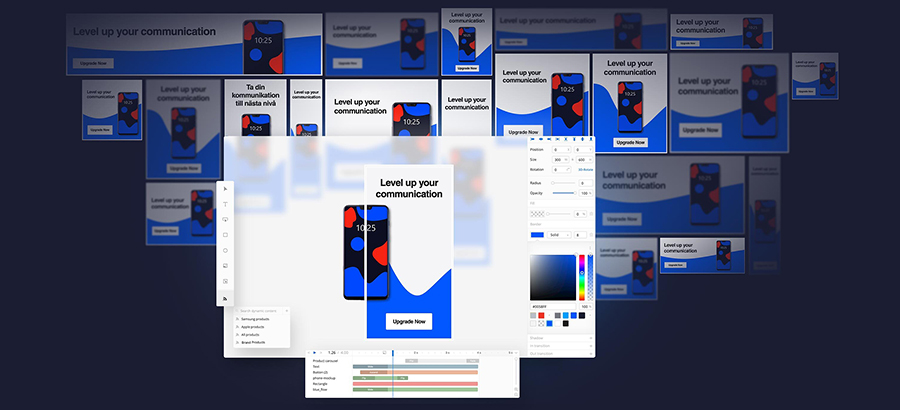
8 marketing trends display advertisers can't ignore in 2016

2016 is at full galopp, which makes it a good idea to make sure you are on top of the year's marketing trends. Here’s our list of trends that marketers and advertisers can’t afford to ignore in 2016.
1. Relationship Marketing
Brands are increasingly realising how important their customers, brand advocates and other parties, such as bloggers, are in promoting their brand. At the same time, brands are getting closer to their customers. Hubspot puts this down to the fact that more and more of us now own smartphones, and therefore, technology is always close at hand and part of our personal lives.
What does this mean for display advertising? It could mean more affiliate programs, getting those who love your brand helping you to spread your brand message. This is a great perk for advertisers as they can target their ads to particular audiences and get their biggest fans spreading the word. This also means that advertisers need to show their other side, the most human aspect that gets people engaged. This could mean that advertisers start advertising their brand values and culture, not just their product.
2. Virtual Reality
Virtual reality or VR is becoming more of a reality with many top influencers citing that VR is going to be a huge trend for marketers in 2016. What does this mean for display advertisers? This means that advertisers are going to have a whole new world (or even thousands of new worlds to advertise in). VR has the potential to reinvent and diversify online display advertising.
However, how advertising in VR will perhaps materialise in 2016 is left to seen, but whether or not VR is going to become a mainstream channel for advertisers is still up for debate with many thinking that it is too immersive for most people. However, there will still be opportunities to connect with early adopters and groups such as gamers. With this in mind, of course, questions about whether we want ads in our virtual worlds. However, with advertising giants such as Facebook taking leaps forward in the world of VR, it's more than likely that monetization through advertising will be at the core of their VR business model.
3. Mobile first advertising
Mobile first isn’t a new phrase, but it is often talked about in the context of web design. 2015 was the year HTML5 banner ads, as advertisers were forced to move away from Flash to reach their audiences of mobile. In 2015, we also saw rich media ads on our mobile phones. 2016 will be the year for creating mobile rich media ads with mobile first in mind as mobile advertising overtakes newspaper advertising. Mobile is now the number one device, and, therefore, more advertisers will be looking to find ways to create a better mobile ad experience.
Also, we'll see the definition of mobile change and start to, of course, include wearable devices, particularly smart watches as more and more people start adding the technology to their personal tech stack.
4. More ad tech
Advertisers and publishers went wild for programmatic in 2015, with a lot of focus on the publishing end of this. Expect more ad tech in 2016 and more spend on ad tech, with a lot of focus on the production end of things instead. With the rise of ad tech, big data and data-driven marketers, more ad tech is going to be essential to reach targets. This means more developments not only in programmatic publishing but also for the programmatic creative, with creativity and data going hand in hand.
Ad tech is going to get more and more advanced so make sure you don’t get bogged down with technical complexity of it all and focus on usability and results instead.
5. Real-time content
According to some different influencers, 2016 will be the year where content marketers start to stray from their editorial calendars and start thinking about content in real-time, and the possibilities for display advertisers are endless.
Content in real-time has worked well for social media, and as more and more companies spend more on content marketing, they have the resources available to build content in real-time fast and to react to unexpected opportunities.
How does this effect display advertising? Ad advertisers start viewing display ads as content for the user rather than just ads they will able to take advantage of this and begin to create bite-sized nuggets of visual content.
Advertisers will expect more flexibility and will demand that technology allows them to create display ads in real-time. While advertisers have long suffered from the totally inflexible banner ads; platforms are starting to appreciate this and enabling them to update banners in real-time through cloud advertising. This is going to be an incredibly powerful tool for display advertisers as they will be able to create more relevant ads to the context around them, which will in turn create more relevant ads for users.
6. The audience of one
We live in a world of personalisation. We have mastered personalised medication and similar, and this trend of marketing and creating solutions for the audience of one will be essential for marketers in 2016. How can we apply this to display advertising? Well, in 2015, programmatic advertising made it easier for advertisers to connect with smaller and smaller segments. We also are starting to see this with retargeting ads that contain content that is specific and relevant to the audience of one. A marketer also showed that it was possible to target one person with the Facebook Custom Audiences platform. So, while the technology is there to target individuals, it is a case of solving production so that marketers can produce ads in a scalable way that are relevant to the individual.
7. Millennials as more than one audience
Oh Millenials, how with love thee. You love to buy, you love social media. 2015 was the year of marketing to millennials. However, marketers saw them as one big juicy lump of cash. However, in 2016 marketers will start to realise that Millennials come in all different shapes and sizes and will begin to segment them according to their habits and interests. What does this mean for display advertising? This means that, as discussed above; advertisers will need to build more creatives that hack into the interests of the viewer, and not just look at millennial as one single segment. More production, more creatives, more programmatic, more of finding the right channels to connect in for millennials.
8. We’ll still be finding a solution to ad blocking
While ad blockers pre-date 2015, 2015 was the year where ad blockers started to get attention in the media and from advertisers and publishers. We are still talking about ad blockers in 2016, whether or not they are ethical, and how publishers and advertisers can avoid them. Of course, there will be a lot of talk about native and content advertising - but with content saturation and a love for the free, unbiased internet expect some anti-content marketing folk to start popping their heads up. After all sponsored content is only advertising in disguise.
There’s a lot to take in this year, and it will be interesting to see how these trends will develop and whether or not the industry gets the write. Personally, I think virtual reality may struggle to kick-off for the mainstream (because who wants to sit with a mobile phone strapped to their head?), think about 3D cinemas - while popular in some segments, we are not all spending every minute of every day looking at 3D. I think finding a solution for ad blocking will be a priority for the industry in 2016, I don’t think native advertising is the way forward, as content quality will inevitably fall if only marketers are producing content and are telling stories to sell.
Share this article







